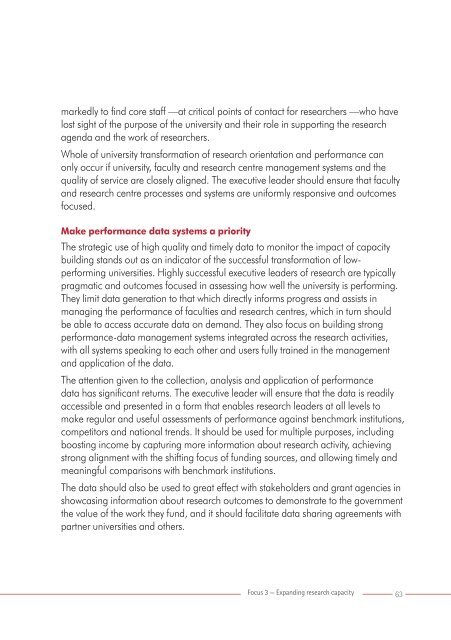handbook-executive-leadership-of-research-development-pdf-v10
handbook-executive-leadership-of-research-development-pdf-v10
handbook-executive-leadership-of-research-development-pdf-v10
Create successful ePaper yourself
Turn your PDF publications into a flip-book with our unique Google optimized e-Paper software.
markedly to find core staff —at critical points <strong>of</strong> contact for <strong>research</strong>ers —who havelost sight <strong>of</strong> the purpose <strong>of</strong> the university and their role in supporting the <strong>research</strong>agenda and the work <strong>of</strong> <strong>research</strong>ers.Whole <strong>of</strong> university transformation <strong>of</strong> <strong>research</strong> orientation and performance canonly occur if university, faculty and <strong>research</strong> centre management systems and thequality <strong>of</strong> service are closely aligned. The <strong>executive</strong> leader should ensure that facultyand <strong>research</strong> centre processes and systems are uniformly responsive and outcomesfocused.Make performance data systems a priorityThe strategic use <strong>of</strong> high quality and timely data to monitor the impact <strong>of</strong> capacitybuilding stands out as an indicator <strong>of</strong> the successful transformation <strong>of</strong> lowperforminguniversities. Highly successful <strong>executive</strong> leaders <strong>of</strong> <strong>research</strong> are typicallypragmatic and outcomes focused in assessing how well the university is performing.They limit data generation to that which directly informs progress and assists inmanaging the performance <strong>of</strong> faculties and <strong>research</strong> centres, which in turn shouldbe able to access accurate data on demand. They also focus on building strongperformance-data management systems integrated across the <strong>research</strong> activities,with all systems speaking to each other and users fully trained in the managementand application <strong>of</strong> the data.The attention given to the collection, analysis and application <strong>of</strong> performancedata has significant returns. The <strong>executive</strong> leader will ensure that the data is readilyaccessible and presented in a form that enables <strong>research</strong> leaders at all levels tomake regular and useful assessments <strong>of</strong> performance against benchmark institutions,competitors and national trends. It should be used for multiple purposes, includingboosting income by capturing more information about <strong>research</strong> activity, achievingstrong alignment with the shifting focus <strong>of</strong> funding sources, and allowing timely andmeaningful comparisons with benchmark institutions.The data should also be used to great effect with stakeholders and grant agencies inshowcasing information about <strong>research</strong> outcomes to demonstrate to the governmentthe value <strong>of</strong> the work they fund, and it should facilitate data sharing agreements withpartner universities and others.Focus 3 — Expanding <strong>research</strong> capacity63



